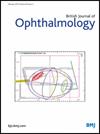眼调节在高度远视婴儿正视化中的作用
IF 3.5
2区 医学
Q1 OPHTHALMOLOGY
引用次数: 0
摘要
目的评估调节滞后(离焦)和调节反应之间的关系,以确定在15个月期间成功达到远视的3个月高度远视婴儿的远视现象。材料和方法将35名高度远视(≥+5.00 D,大部分远视经线)3个月大的婴儿(57%为女性)纳入临床试验([NCT03669146][1]),以确定部分屈光矫正(完全矫正减少3.0 D)和视觉锻炼刺激调节对正视化(达到<+3.0 D)的影响。通过睫状体麻痹(1%环pentolate)视网膜镜获得屈光误差,在近距离(33 cm)和近距离(6 m)和近距离(33 cm)使用PlusOptix powerrefrator (PlusOptix,纽伦堡,德国)用单眼估计法(MEM)评估调节。利用球面等效屈光差变化作为调节滞后和调节响应函数的重复测量回归模型,分析了调节响应和滞后对正视化的影响。结果远视丧失程度越高,远处(用PowerRefractor测量)和近处(用MEM测量)的调节反应越强。这些关系随着年龄的增加而增强,在18个月时达到B= - 0.32和B= - 0.47屈光度/屈光度调节反应(反应与年龄之间的交互作用分别为距离和距离p=0.004和p<0.001)。线性回归分析显示屈光不正的变化与远近离焦之间没有显著的关联。结论与以散焦为基础的远视模型相反,较大的调节反应和非远视散焦对远视婴儿远视率的影响更大。如有合理要求,可提供资料。数据可根据审稿人的要求提供,通信作者(AM)可以根据具体情况处理请求。[1]: /查找/ external-ref ? link_type = CLINTRIALGOV&access_num = NCT03669146&atom = % 2 fbjophthalmol % 2恐惧% 2 f2025 % 2 f10 % 2 f15 % 2 fbjo - 2025 - 327682. -原子本文章由计算机程序翻译,如有差异,请以英文原文为准。
Role of ocular accommodation in emmetropisation among highly farsighted infants
Purpose To assess the relationship between accommodative lag (defocus) and accommodative response to determine which drives emmetropisation in highly farsighted 3-month-old infants who successfully reached emmetropia in a 15-month period. Materials and methods 35 highly hyperopic (≥+5.00 D most hyperopic meridian) 3-month-old infants (57% female) were enrolled in a clinical trial ([NCT03669146][1]) to determine the effect on emmetropisation (reaching <+3.0 D) of partial refractive correction (full correction reduced by 3.0 D) and visual exercises to stimulate accommodation. Refractive error was obtained by cycloplegic (1% cyclopentolate) retinoscopy and accommodation was assessed with the monocular estimation method (MEM) at near (33 cm) and with the PlusOptix PowerRefractor (Plusoptix, Nuremberg, Germany) at distance (6 m) and near (33 cm). The effect of accommodative response and lag on emmetropisation was analysed using a repeated measures regression model of change in spherical equivalent refractive error as a function of accommodative lag and accommodative response. Results Greater loss of hyperopia was associated with more robust accommodative response at both distance (measured with the PowerRefractor) and near (measured with MEM). These relationships increased in strength with increasing age, reaching B=−0.32 and B=−0.47 diopters of loss of hyperopia per diopter of accommodative response at 18 months (interaction between response and age p=0.004 and p<0.001 for distance and near, respectively). Linear regression analyses showed no significant associations between change in refractive error and defocus at distance or near. Conclusion Contrary to defocus-based models of emmetropisation, greater accommodative response and not hyperopic defocus had the stronger influence on the rate of emmetropisation in hyperopic infants. Data are available upon reasonable request. Data are available upon request from reviewers and the corresponding author (AM) can handle requests on a case by case basis. [1]: /lookup/external-ref?link_type=CLINTRIALGOV&access_num=NCT03669146&atom=%2Fbjophthalmol%2Fearly%2F2025%2F10%2F15%2Fbjo-2025-327682.atom
求助全文
通过发布文献求助,成功后即可免费获取论文全文。
去求助
来源期刊
CiteScore
10.30
自引率
2.40%
发文量
213
审稿时长
3-6 weeks
期刊介绍:
The British Journal of Ophthalmology (BJO) is an international peer-reviewed journal for ophthalmologists and visual science specialists. BJO publishes clinical investigations, clinical observations, and clinically relevant laboratory investigations related to ophthalmology. It also provides major reviews and also publishes manuscripts covering regional issues in a global context.

 求助内容:
求助内容: 应助结果提醒方式:
应助结果提醒方式:


